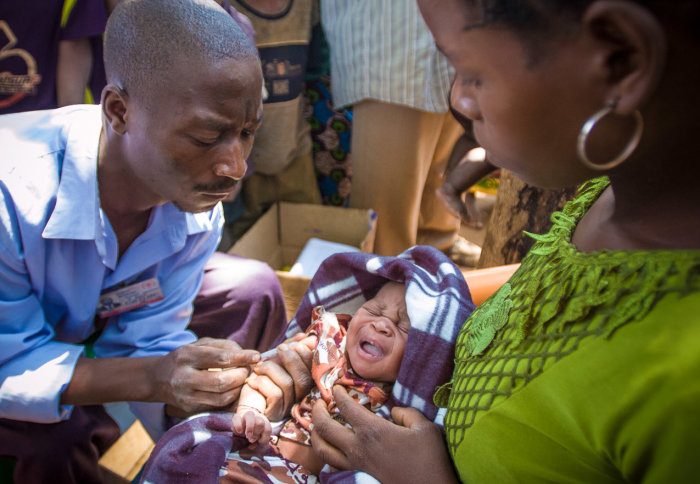Childhood TB burden could be reduced by better targeting of high-risk households

Study reveals untapped potential of household contact management strategies as UN General Assembly gathers for first-ever high-level meeting on TB.
Tuberculosis (TB) is currently the leading infectious cause of death worldwide. Each year, millions of children develop TB infection after being exposed to an infectious adult in their home. TB infection is a symptomless state, but one that can lead to TB disease at a later stage in a child’s life. It is estimated that each year one million children develop TB disease, of whom a quarter die.
The World Health Organization (WHO) recommends that after an adult has been diagnosed with TB, household contact investigations take place and all children are screened for TB disease. For children under five years who are free from the disease, it is recommended that they are given preventive therapy. However, there are major gaps in how these guidelines are implemented. Globally, only 13% of eligible children under five are estimated to receive preventive therapy.
In an effort to find new approaches to reducing the burden of childhood TB disease and death, a team of researchers - led by academics at University of Sheffield and Imperial College London, working in collaboration with colleagues at University of York, Boston University and Harvard University - have developed a mathematical modelling framework to estimate the benefits of implementing the WHO’s recommendations for child-targeted household contact interventions.
Modelling morbidity and mortality
The team set out to assess the impact of full versus zero household contact management coverage for the global population of children under 15 years living with adult TB patients. The researchers first developed a regression model to estimate, for every country in the world, the number of children of different ages that live in homes with adults with infectious TB on a yearly basis. Secondly, they constructed a decision tree model to chart the potential routes that the children could take in terms of disease progression and death, with associated probabilities for each eventuality.
They then used their model, and available data, to assess three scenarios:
- Scenario A: the current status quo, in which household contact management is not routinely undertaken in high-burden settings
- Scenario B: implementation of household contact management with screening of all children for TB disease and preventive therapy for all children under five years
- Scenario C: implementation of household contact management with screening of all children for TB disease and preventive therapy for all children under five years, as well as preventive therapy for children between five and fifteen years who have a positive test of TB infection.
To assess the highest possible impact for Scenarios B and C, the team assumed complete intervention coverage. In each scenario, the diagnosis of childhood TB disease was made using the diagnostic tools routinely available in a high-burden setting. In terms of morbidity, the team found that Scenario B averted 66,700 cases of TB disease, and Scenario C averted 159,500 cases. When estimating mortality, they found that Scenario B would lead to 103,600 fewer deaths, with 108,400 childhood deaths being averted in Scenario C. In both scenarios, the largest number of averted deaths were in children under five. The team also found that the WHO South-East Asia region had the largest share of preventable deaths.
Barriers and next steps
"A huge number of lives could be saved by implementing measures that have been proven to work" Dr James Seddon Clinical Senior Lecturer in Paediatric Diseases
The team behind the study acknowledge that a number of questions need to be answered if the WHO recommendations on household contact management are to be put into practice consistently, and on a global scale. While more work needs to be done in terms of evaluating the costs and logistics of implementation, the researchers hope that their findings will act as a first step towards better global planning.
Dr Peter Dodd, the paper's first author, said: “This study is limited by a lack of data for many countries, but as better data become available, it will allow a better refinement of the model. In addition, the model could be used on a country-by-country basis, and a within-country basis, to evaluate more local impact. With the UN high-level meeting on TB coming up, we hope that our study might prompt policy-makers to prioritise household contact management strategies in order to prevent childhood TB deaths.”
Dr James Seddon from Imperial's Department of Medicine, the paper’s last author, commented that: “The majority of cases of childhood TB are preventable and treatable. Children, therefore, really should not be dying of TB. Yes, we need better tests, better drugs and better vaccines, but a huge number of lives could be saved by implementing measures that have been proven to work.”
'Potential effect of household contact management on childhood tuberculosis: a mathematical modelling study' by Peter J Dodd et al. is published in The Lancet Global Health.
Lead image credit: Tim Cowley [CC BY-SA 4.0 (https://creativecommons.org/licenses/by-sa/4.0)], from Wikimedia Commons
Article supporters
Article text (excluding photos or graphics) © Imperial College London.
Photos and graphics subject to third party copyright used with permission or © Imperial College London.
Reporter
Ms Genevieve Timmins
Academic Services